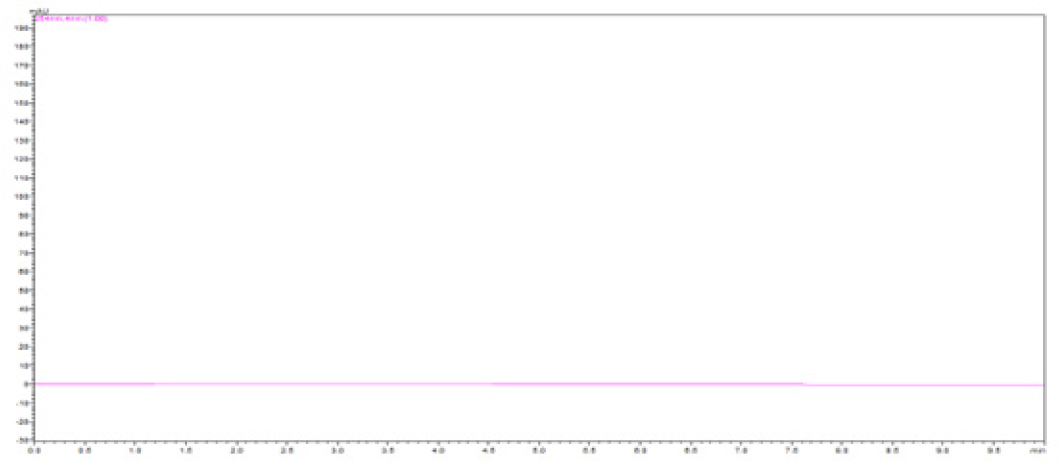ABSTRACT
Objectives
A novel, precise, and accurate RP-HPLC method was developed and validated for the determination of valganciclovir in pure and medicinal dose form. Cytomegalovirus infections were treated with the antiviral medication valganciclovir. Ganciclovir was first phosphorylated by viral protein kinase into the monophosphate form in cytomegalovirus-infected cells. Afterwards, it was converted to its triphosphate form by cellular kinases.
Materials and Methods
The analyte separation was obtained by Shimadzu C18 column. Mobile phase was in the ratio (20:80v/v) of acetonitrile and 0.05% of orthophosphoric acid. Flow rate of 0.6mL/min was used. The wavelength of the drug was at 254nm with a retention time of 3. 761 min.
Results
The regression equation of valganciclovir was found to be y=56286x+50633, with a R2 value of 0. 9993. It was reported that the precision percent RSD was under 2%. The rate of valganciclovir recovery was 99.43%. Valganciclovir LOD and LOQ were determined to be 0.1 μg/mL and 0.3μg/mL, respectively.
Conclusion
The proposed method was shown to be exact, accurate, and perfect for usage in QC labs for quantitative analysis of pharmaceutical dosage forms, both single and combined.
INTRODUCTION
Chemically, valganciclovir was 2-[(2-amino-6-oxo- 6,9-dihydro-3H-purin-9-yl) methox yl-3-hydroxypropyl- (2S)-2-amino-3-methylbutanoate. C14H22N6O5 HCl was the chemical formula, and its molecular weight was 390.83 g/mol. It was found to be easily soluble in methanol and water but insoluble in ether. It was available as white crystals.1 Cytomegalovirus infections were treated with the antiviral medication valganciclovir. Ganciclovir was first phosphorylated by viral protein kinase into the monophosphate form in cytomegalovirus-infected cells. After then, it was converted to its triphosphate form by cellular kinases.2
According to a review of the valganciclovir literature, UV methods,1–3 LC-MS methods4–8 and RP-HPLC methods9–13 were published up to this point. The study’s major objective was to create an easy, precise RP-HPLC method for the measurement of valganciclovir in both pure and tablet dose forms. Figure 1 represented the chemical structure of valganciclovir.
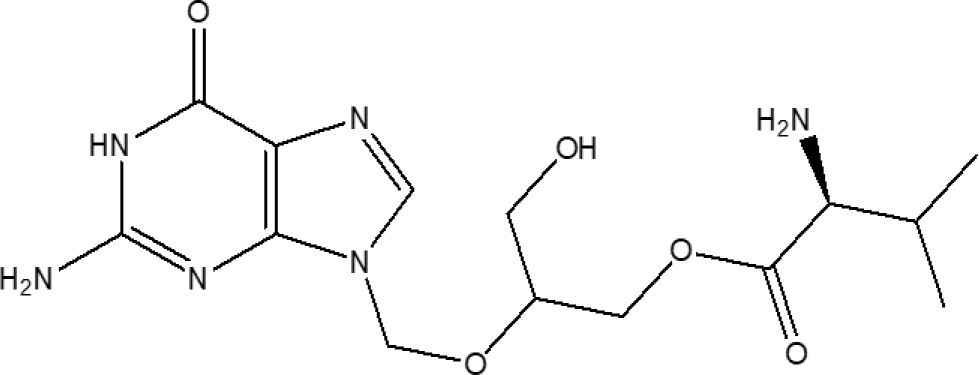
Figure 1:
Structure of valganciclovir.
MATERIALS AND METHODS
Chemicals and reagents
Valganciclovir sample was used for analysis. Orthophosphoric acid was purchased from Loba Chemie and acetonitrile was purchased from Rankem Ltd., HPLC grade water was purchased from SRL.
Instruments and equipment
Shimadzu HPLC system provided with binary pumps with PDA detector was used. The solutions pH was calibrated by using Elico111 pH meter. Shimadzu 0.1mg analytical balance was used for weighing purpose.
Method of Analysis
Preparation of standard stock solutions
10mg of valganciclovir was weighed and relocated into a 10 mL volumetric flask. Volume was made up with HPLC grade methanol. The obtained standard stock solution was 1000 µg/mL.
Preparation of standard working solutions
1 mL of the solution from the standard stock was transferred into a 10 mL volumetric flask. The volume was made up by diluent (100 µg/mL).
Preparation of diluents
Diluent was prepared using methanol and Orthophosphoric Acid (OPA) (70:30 v/v).
Preparation of sample stock solutions
20 tablets were taken and weighed. Later on, the average weight of each individual tablet was determined. The weight equivalent to 1 tablet was taken into a 100mL volumetric flask and 50mL of methanol was added. Sonication was done for 15 min. Filtration of the solution was done by HPLC syringe filter and volume was made up by methanol (1000µg/mL).
Preparation of sample working solutions
From the filtered stock solution, 1mL was taken and pipetted out into a 10mL volumetric flask and made up the volume with diluent (100µg/mL).
Chromatographic conditions
The RP-HPLC method development and validation of valganciclovir was carried on Shimadzu C18 column. Mobile phase consisted of 0.05% ortho phosphoric acid: acetonitrile in the ratios of 80:20 v/v with a flow rate of 0.6 mL/min. The sample injector volume was 20 µL. Temperature of column was ambient. The wavelength of valganciclovir from the UV spectrum was 254 nm. Analyte eluted was observed at 254 nm. Table 1 listed the chromatographic conditions, and Figure 2 represented the optimised chromatogram.

Figure 2:
Optimized chromatogram of valganciclovir.
| Parameter | Chromatographic conditions |
|---|---|
| Stationary phase | Shimadzu C18 |
| Mobile phase | 0.05% OPA: Acetonitrile (80:20) |
| Column temperature | Ambient |
| Injection volume | 20µL |
| Total run time | 10 min |
| Detector | PDA |
| Elution | Isocratic mode |
| Flow rate | 0.6mL/min |
| λmax | 254nm |
Optimized chromatographic conditions.
Method development
Trial 1 was carried out by using 0.05% OPA: methanol in the ratio of 70:30. Trial 2 was conducted out by using 0.05% OPA: acetonitrile in the ratio of 80:20. Trial 3 was involved out by using 0.1% OPA: acetonitrile in the ratio of 80:20. Trial 4 was included out by using 0.1% OPA: methanol in the ratio of 30:70. The method optimization was done in the trial 5 by 0.05% OPA: acetonitrile.
Method validation
System suitability parameters
6 duplicate injections of the drug standard solution of 10µg/mL were injected into HPLC system and the system suitability parameters were determined. Peak area, the number of theoretical plates, and the tailing factor were noted.14
Specificity
The specificity was evaluated by loading samples into the HPLC system. Drug solution was compared to the blank solution. The output chromatograms were examined for the interference between a drug peak response and a blank response.15
Linearity
Distinct drug standard solution of valganciclovir was diluted in different concentrations of drug stock solutions that ranged from 0.1to 100µg/mL. These solutions were prepared for evaluation of linearity. The calibration curve’s linearity plot was evaluated using coefficient of correlation value.16
Sensitivity
The following equations, that were based on the slope of the calibration and the standard deviation of the responses using various concentrations of the standard stock solution, were used to calculate the limit of detection and limit of quantification.17
- Limit of detection= 3.3 × standard deviation of the response/slope of calibration curve of the analyte.
- Limit of quantification=10 × standard deviation of the response/slope of calibration curve of the analyte.
Accuracy
Determination of accuracy was done at 3 different levels 50%, 100% and 150%. Known amount of sample stock solution of valganciclovir was added to the standard stock solution. %recovery was calculated.18
Precision
Precision was studied as intraday and interday. Intraday precision was calculated by 3 different concentrations of solutions that were injected three times in the same day. Peak area was determined and the %RSD was calculated. Interday precision was calculated by the peak area of 3 different concentrations in3 times in a week.19
Robustness
The determination of the robustness was done by injecting the samples by varying the mobile phase ratio and flow rate.20
Forced degradation studies
Oxidation
0.1mL of the solution was pipetted out from the standard stock solution of valganciclovir and 30% of 1mL hydrogen peroxide was added to it. The solution was heated at 60°C for 30 min in a water bath. The solution was cooled and brought to room temperature, and the volume was made up of diluent. Solution of 20 µL was injected into the HPLC system.21
Acid degradation
1 mL of 0.1N of HCl was added to 0.1mL of the solution from the standard stock solution of 10 µg/mL. The solution was heated for 30 min at 60°C before being cooled to room temperature. 0.1N of NaOH (0.5 mL) was added to the solution to neutralize it, then the volume was made by diluent.
Alkali degradation
From the standard stock solution of (10µg/mL), 0.1mL of the sample was taken and added to the 0.1N of NaOH (1mL). Solution was heated for 30 min at 60°C. 0.5 mL of 0.1N HCl was added to the solution to neutralise it after it was cooled. Diluent was used to made up the volume.
Thermal degradation
0.1mL of the standard stock solution was added to the 10mL volumetric flask and volume was made up by diluent. Solution was heated for 30 min at 60°C. Solution was cooled before it was injected into the HPLC.
Photolytic degradation
0.1 mL from the stock solution was taken and exposed to the UV light at 254 nm for 30 min. Sample was injected into the HPLC system after the volume was made up with diluent.22
RESULTS
Method Optimization of Chromatographic Conditions
UV spectroscopic analysis of the drug showed maximum absorbance at 254 nm. An appropriate and precise HPLC technique for analysis of valganciclovir was employed after several trials with different mobile phases were done. The 1st trial started with 0.05% OPA: methanol in the ratio of 70:30. But this trial was not selected as broad peak shape was observed. Second trail was done by 0.05% OPA: acetonitrile in the ratio of 80:20 with the flow rate of 1.0 mL/min. The trial was not selected as broad peak shape was observed. 3rd trial was done by 0.1% OPA: acetonitrile in the ratio of 80:20. But this trial was not selected as broad peak shape was observed. 4th trial was done by 0.1% OPA: methanol in the ratio of 30:70 with the flow rate of 0.8mL/min. The trial was not selected as peak splitting was observed. The 5th trial was optimized by 0.05% OPA: acetonitrile with the flow rate of 0.6mL/min. The obtained chromatogram was found to be in good shape.
Method validation
System suitability parameters
The theoretical plates for valganciclovir were over 2000, and the tailing factor was under two, according to the parameters. Table 2 displayed statistics on system appropriateness.
| Parameter | Valganciclovir |
|---|---|
| Retention time | 3.767 min |
| Theoretical plates | 7518.384 |
| Tailing factor | 1.287 |
System suitability parameters.
Linearity
Linearity equation for valganciclovir was found to be y = 56286+50633 with a correlation value of 0. 9993. The linearity data was provided in Table 3. Figure 3 showed the calibration curve of valganciclovir.
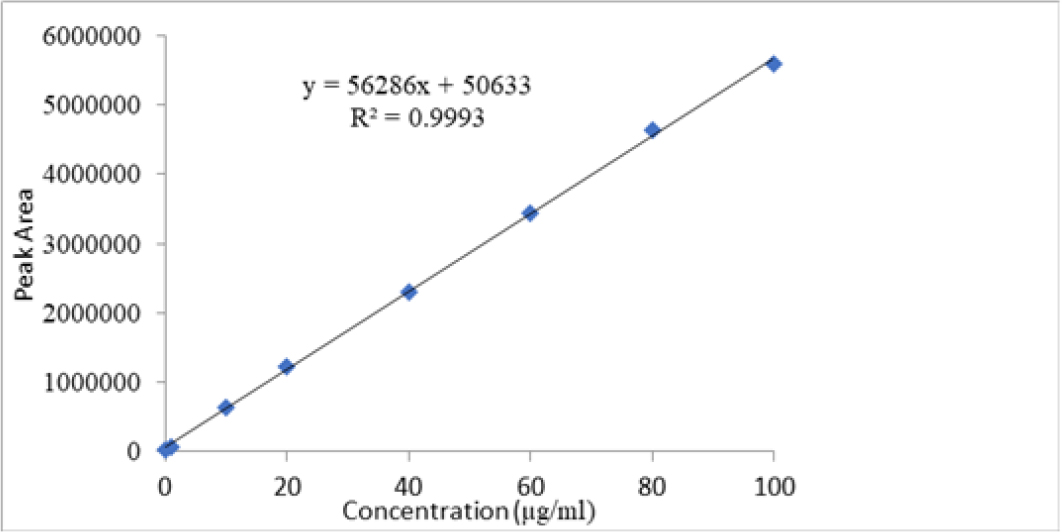
Figure 3:
Calibration curve of valganciclovir.
| Concentration (µg/mL) | Peak area |
|---|---|
| 0.1 | 20496 |
| 1 | 68160 |
| 10 | 625665 |
| 20 | 1233345 |
| 40 | 2298809 |
| 60 | 3429553 |
| 80 | 4647527 |
| 100 | 5592070 |
Linearity data of valganciclovir.
Accuracy
The recovery rate was between 99.66 and 99.84%. In Table 4, the accuracy results were provided.
| Recovery level | Amount spiked | Amount total | Amount recovered | %Recovery | Mean | Standard deviation | %Relative standard deviation |
|---|---|---|---|---|---|---|---|
| 50% | 10 | 30 | 29.72 | 99.07 | 99.66 | 0.09 | 0.09 |
| 50% | 10 | 30 | 30.02 | 100.07 | |||
| 50% | 10 | 30 | 29.95 | 99.83 | |||
| 100% | 20 | 40 | 39.93 | 99.83 | 99.84 | ||
| 100% | 20 | 40 | 39.72 | 99.30 | |||
| 100% | 20 | 40 | 40.15 | 100.38 | |||
| 150% | 30 | 50 | 49.09 | 98.18 | 99.76 | ||
| 150% | 30 | 50 | 50.56 | 101.12 | |||
| 150% | 30 | 50 | 49.99 | 99.98 |
Accuracy data of valganciclovir.
System precision
System precision %RSD was 0.05-0.15. Data related to system accuracy were displayed in Table 5. Chromatogram data for the system’s precision demonstrated that the %RSD was 0.05-0.15.
| Concentration | Peak area | %Label claim | Mean | Standard deviation | %Relative standard deviation |
|---|---|---|---|---|---|
| 20 | 1173275 | 19.94 | 19.95 | 0.03 | 0.15 |
| 1172364 | 19.92 | ||||
| 1175243 | 19.98 | ||||
| 40 | 2301077 | 39.98 | 40.06 | 0.107 | 0.27 |
| 2302767 | 40.01 | ||||
| 2312456 | 40.18 | ||||
| 60 | 3417789 | 59.82 | 59.83 | 0.03 | 0.05 |
| 3416874 | 59.80 | ||||
| 3420076 | 59.86 |
System precision data of valganciclovir.
Repeatability
Data from the chromatogram for repeatability showed that the %RSD was 0.095. Table 6 represented the results regarding repeatability.
| Sl. No | Area of valganciclovir |
|---|---|
| 1 | 625249 |
| 2 | 624991 |
| 3 | 625109 |
| 4 | 625245 |
| 5 | 624982 |
| 6 | 626545 |
| Mean | 625353.5 |
| Standard deviation | 595.24 |
| %Relative Standard deviation | 0.095 |
Repeatability of valganciclovir.
Intermediate Precision
Chromatogram values for intermediate precision revealed that the %RSD was 1.2. The outcomes were shown in Table 7.
| Day | Concentration | Peakarea | %Label claim | Mean | Standard deviation | %Relative standard deviation |
|---|---|---|---|---|---|---|
| Day 1 | 20 | 1173298 | 19.94 | 19.96 | ||
| 1174987 | 19.97 | |||||
| 1174852 | 19.97 | |||||
| Day 2 | 20 | 1172996 | 19.94 | 20.01 | 0.025 | 0.125 |
| 1180192 | 20.06 | |||||
| 1178896 | 20.04 | |||||
| Day 3 | 20 | 1177242 | 20.01 | 19.99 | ||
| 1175769 | 19.98 | |||||
| 1175972 | 19.99 | |||||
| Day 1 | 40 | 2297872 | 39.92 | 40.00 | ||
| 2310895 | 40.15 | 0.629
| ||||
| 2298753 | 39.94 | |||||
| Day 2 | 40 | 2302767 | 40.01 | 38.89 | ||
| 2289756 | 39.78 | 1.58 | ||||
| 2296578 | 39.90 | |||||
| Day 3 | 40 | 2296895 | 39.90 | 39.96 | ||
| 2301922 | 39.99 | |||||
| 2302125 | 40.00 | |||||
Intermediate precision of valganciclovir.
Robustness
The %RSD of flow plus, flow minus, mobile phase plus, and mobile phase minus were found to be 0.08, 0.59, 0.58, and 0.59% respectively. Table 8 provided an illustration of the outcomes.
| Sl. No | Condition | %Relative standard deviation of valganciclovir |
|---|---|---|
| 1 | Flow rate (-)0.5mL/min | 0.08 |
| 2 | Flow rate (+)0.7mL/min | 0.59 |
| 3 | Mobile phase (-)18B:82A | 0.58 |
| 4 | Mobile phase (+)22B:78A | 0.59 |
Robustness data of valganciclovir.
Specificity
Sensitivity
Valganciclovir LOD was found to be 0.1 µg/mL. Valganciclovir LOQ was found to be 0.3µg/mL.
Assay
Percentage purity was found to be 99.43%. The assay chromatogram was shown in Figure 5.
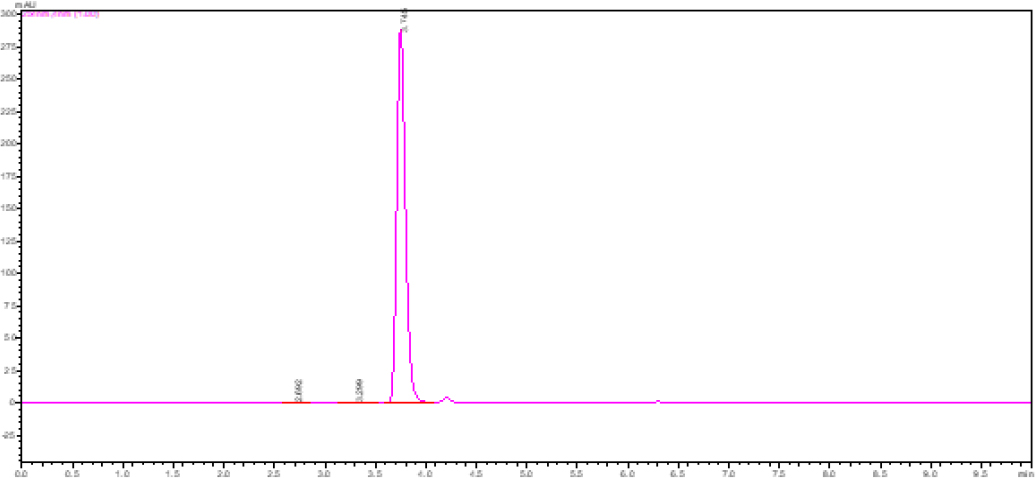
Figure 5:
Chromatogram of assay.
Forced degradation studies
Drug samples that had degraded to various percentages included 14.8%, 3.1%, 0.8%, 3.3%, 3.7%. Table 10 represented the forced degradation studies data. Figures 6–10 listed the chromatograms for the many types of degradation, including acid, basic, oxidative, thermal, photolytic.
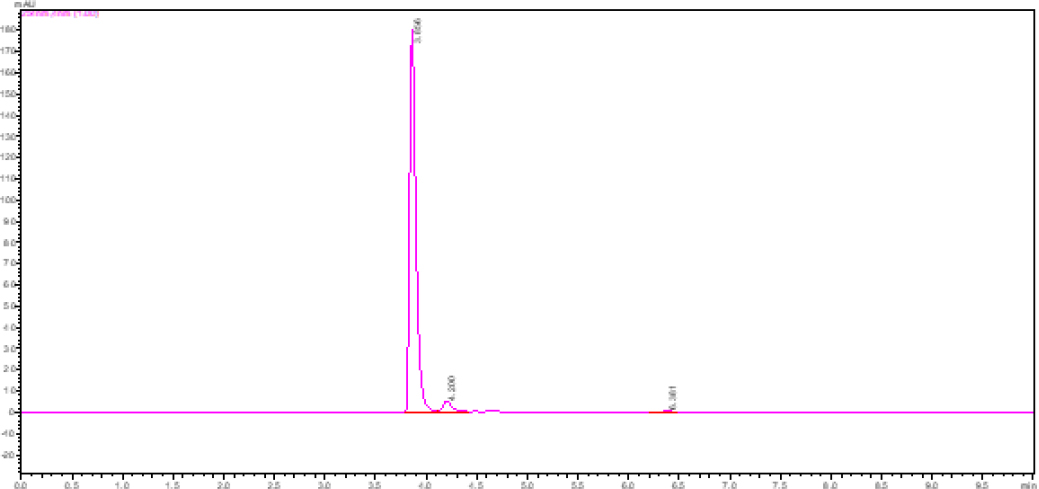
Figure 6:
Chromatogram of acidic degradation of valganciclovir.
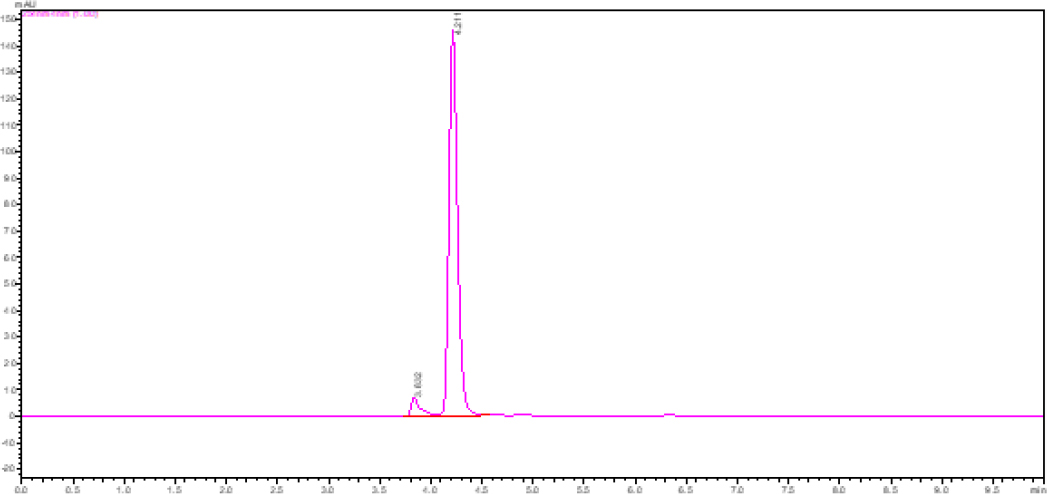
Figure 7:
Chromatogram of basic degradation of valganciclovir.

Figure 8:
Chromatogram of peroxide degradation of valganciclovir.
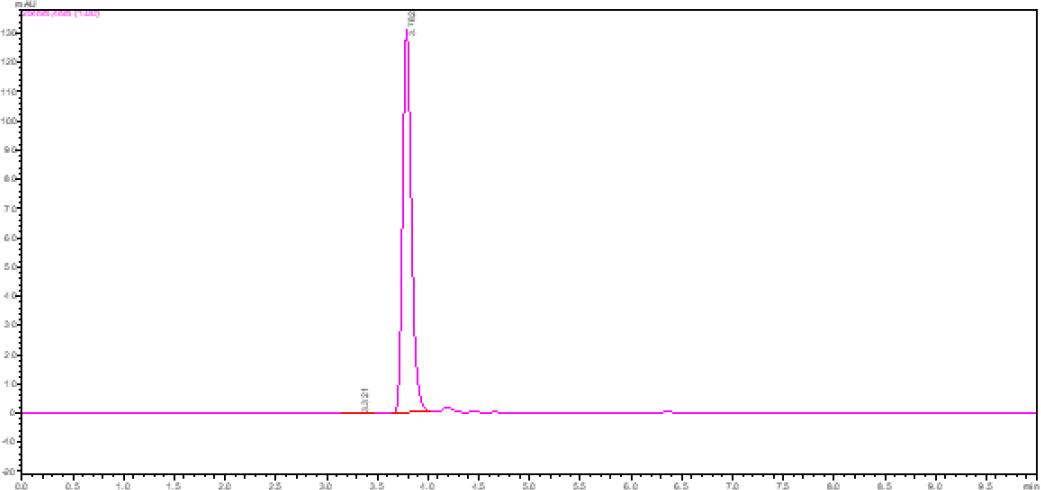
Figure 9:
Chromatogram of thermal degradation of valganciclovir.
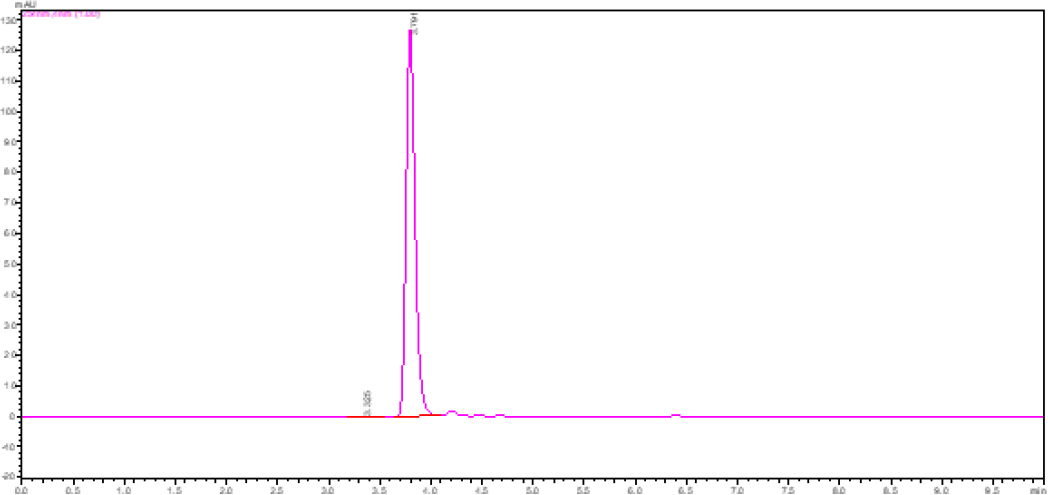
Figure 10:
Chromatogram of photolytic degradation of vaganciclovir.
| Sl. No | Degradation condition | %Drug degraded | %Drug undegraded | Retention time | Peak area |
|---|---|---|---|---|---|
| 1 | Acid | 3.3 | 96.7 | 3.856 | 730934 |
| 2 | Alkali | 3.7 | 96.3 | 4.211 | 727400 |
| 3 | Oxidation | 14.8 | 85.2 | 3.797 | 643683 |
| 4 | Thermal | 0.8 | 99.2 | 3.782 | 749146 |
| 5 | Photo stability | 3.1 | 96.9 | 3.791 | 732246 |
Forced degradation studies data of valganciclovir.
DISCUSSION
RP-HPLC technique for the quantification of valganciclovir in the pure and tablet dosage forms was developed and validated as per ICH guidelines. The analyte separation was obtained by Shimadzu C18 column. Mobile phase was in the ratio (20:80 v/v) of acetonitrile and 0.05% of orthophosphoric acid. Flow rate of 0.6mL/min was used. The wavelength of the drug was at 254nm with a retention time of 3.761 min.
The development of the method required a system suitability test that ensured the system was appropriate for the analysis of valganciclovir. A proper protocol was established to ensure that the HPLC equipment executed techniques that produced findings with an acceptable level of accuracy and precision prior to the analysis of samples from each day. With the proposed HPLC approach, linearity was attained at a concentration range of 0.1-100 µg/mL. When the correlation coefficient was found to be within accepted limits, acceptable linearity was indicated.
The conventional addition technique was used to obtain accuracy samples at three levels (50%, 100%, and 150%). The method’s high recovery rates demonstrated that the suggested approach can be used for quality control examination of tablet dosage forms. The maximum limit for system precision was %RSD not more than 2.0%). Thus, it demonstrated that the procedure was determined to be accurate. The repeatability of the chromatograms was found to be within the predetermined limit (%RSD not more than 2.0%). As a result, it proved that the method was found to be repeatable.
The limit specified (%RSD not more than 2.0%) for chromatogram data with intermediate precision was determined to be met. Thus, it demonstrated that the procedure was determined to be effective. The robustness was evaluated by introducing small, deliberate changes to the chromatographic conditions, which include the ratios of 0.05% OPA and acetonitrile in the mobile phase (18:82 and 22:78), and the flow rate of the mobile phase (0.5 and 0.7 mL/min). Valganciclovir 40 µg/mL was used to test robustness and the %RSD was discovered to be robust. Specificity was examined by introducing a blank solution into the HPLC apparatus. This showed that there was no interference in the blank sample at the retention time of the standard valganciclovir sample. At the retention time of the typical valganciclovir sample, there was no interference with the blank sample. So, the procedure was specific, as can be seen. LOD was defined as about S/N 3 and LOQ as the minimal verified concentration with (%) RSD and (%) error 20%, all of which were taken into consideration when calculating LOD and LOQ.LOD and LOQ were found to be sensitive.
As per the label claim, the amount of drug content obtained from the sample solutions values was in the permissible 90-110% range. The peak of valganciclovir was eluted at 3.748 min.
Valganciclovir was degraded by oxidation (14.8%), photolytic decay (3.1%), thermal decay (0.8%), acid degradation (3.3%), and alkali degradation (3.7%). Less than 15% of the results suggested that valganciclovir was more resistant to all forced degradation conditions used. In addition to the drug peak, there was another peak during basic, oxidative, and acidic breakdown at minutes 3.832, 4.202, and 4.200. The parameters for system suitability were within acceptable limits. Table 11 represents the summary of the approach that was created and verified.
| Parameters | Values | Limit | |
|---|---|---|---|
| Linearity(µg/mL) | 0.1-100(µg/mL) | ||
| Regression coefficient | 0.9993 | R<1 | |
| Slope(m) | 56286 | ||
| Intercept(c) | 50633 | ||
| Regression equation (y= mx +c) | Y=56286x+50633 | ||
| Assay (% mean assay) | 99.43% | 90-110% | |
| Specificity | Specific | No interference of any peak | |
| System precision (%RSD) | 0.05-0.27 | NMT 2.0% | |
| Intermediate precision (%RSD) | 0.125-1.58 | ||
| Repeatability (%RSD) | 0.095 | ||
| LOD | 0.1 | NMT 3 | |
| LOQ | 0.3 | NMT 10 | |
| Flow rate (-) 0.5mL/min | 0.08 | %RSD NMT 2.0 | |
| Robustness | Flow rate (+) 0.7mL/min | 0.59 | |
| Mobile phase (-) 18B:82A | 0.58 | ||
| Mobile phase (+) 22B:78A | 0.59 |
Summary.
CONCLUSION
The proposed method was authenticated for a various parameter, included accuracy, precision, linearity, specificity, system suitability, and robustness, as specified by ICH requirements. The results attained fit the criteria for approval. The method can therefore be used successfully for the routine analysis of valganciclovir in bulk and pharmaceutical dose forms as it is easy to use, precise, inexpensive and safe.
References
- Satish K, Srinivasan R. Development and validation of new spectroscopic method for the estimation of valganciclovir HCl in bulk and pharmaceutical dosage form. World J Pharm Res.. 2021;3(3):4773-82. [Google Scholar]

- Mondal S, Sunil Reddy G, Mondal P, Prathyusha VS, Nair AP, Rahaman ST, et al. Development and validation of few UV spectrophotometric methods for the determination of valganciclovir in bulk and pharmaceutical dosage form. Pharm Methods. 2018;9(2):64-8. [CrossRef] | [Google Scholar]

- BahlulAwen ZVBR, Chandu D. New simple UV spectrophotometric method for the estimation of valganciclovirin bulk and its formulation. Int J Pharm Sci Res.. 2011;2(1):Array [CrossRef] | [Google Scholar]

- Annapurna MM. Stability indicating liquid chromatographic method for the quantitative determination of valganciclovir in Pharmaceutical Dosage forms. J Drug Deliv Ther.. 2013;3(3):64-70. [CrossRef] | [Google Scholar]

- Sawant S, Barge V.. A validated stabilityindicating RP-HPLC method for valganciclovir, identification and characterization of forced degradation products of valganciclovir using LC-MS/MS. Acta Chromatographica. 2014;26(1):29-42. [CrossRef] | [Google Scholar]

- Singh O, Saxena S, Mishra S, Khuroo A, Monif T.. Determination of valganciclovir and ganciclovir in human plasma by liquid chromatography tandem mass spectrometric detection. Clin Biochem. 2011;44(10-11):907-15. [PubMed] | [CrossRef] | [Google Scholar]

- Heinig K, Wirz T, Gajate-Perez A, Belli S. Determination of ganciclovir and its prodrug valganciclovir by hydrophilic interaction liquid chromatography–tandem mass spectrometry. J Chromatogr B Analyt Technol Biomed Life Sci.. 2011;879(5-6):436-42. [PubMed] | [CrossRef] | [Google Scholar]

- Xu H, Li X, Chen W, Liu G, Chu N, Yu C., et al. A sensitive assay for simultaneous determination of plasma concentrations of valganciclovir and its active metabolite ganciclovir by LC/MS/MS. J Chromatogr B. 2007;848(2):329-34. [CrossRef] | [Google Scholar]

- Dogan-Topal B, Uslu B, Ozkan SA. Development and validation of an RP-HPLC method for determination of valganciclovir in human serum and tablets. Chromatographia. 2007;66(S1):97-101. [CrossRef] | [Google Scholar]

- Krishna VN, Gowramma B, Madhuri L. Development and validation of stability indicating RP-HPLC method for the determination of valganciclovir HCl. Res Rev J Pharm Anal. 2014;3(1):2347 [CrossRef] | [Google Scholar]

- Lakshmi Surekha M, Kumara Swamy G. Validated RP-HPLC method for the estimation of valganciclovir in bulk and tablet dosage form. World J Pharm Res. 2013;2(4):959-69. [CrossRef] | [Google Scholar]

- Suresh Kumar R, Hariram B, Divya G, Srinivasu MK, Srinivas K, Sagyam RR, et al. Development of a RP-LC method for a diastereomeric drug valganciclovir hydrochloride by enhanced approach. J Pharm Biomed Anal. 2012;70:101-10. [PubMed] | [CrossRef] | [Google Scholar]

- Manikaya Rao T, Prabhakar T, Girija Sankar G. Development and validation of new stability indicating HPLC method for determination of valganciclovir in tablet dosage form. Int J Pharm Sci. 2012;2(4):101-4. [PubMed] | [CrossRef] | [Google Scholar]

- Anjaneyulu Reddy B, Radhakrishnan P, Irshad Alam M. A validated stability indicating RP-HPLC method development for anticancer drug enzalutamide in bulk and pharmaceuticals. Int J Pharm Sci Drug Res. 2019;13(3):85-90. [PubMed] | [CrossRef] | [Google Scholar]

- Latha ST, Thangadurai SA, Jambulingam M. Developmentand validation of RP-HPLC method for the estimation of erlotinib in pharmaceutical formulation. J Pharm Sci. 2011;4(3):637-8. [PubMed] | [CrossRef] | [Google Scholar]

- Bhanu P, Sundararajan R, Prathyusha P, Mukthinuthalapati MA. A new stability indicating RP-UFLC method for determination of luliconazole in bulk and pharmaceutical formulation. Res J Pharm Technol.. 2020;13(6):2859-63. [CrossRef] | [Google Scholar]

- Szepesi G, Gazdag M, Mihályfi K.. Selection of high-performance liquid chromatographic methods in pharmaceutical analysis, III. Method validation. J Chromatogr. 1989;464(2):265-78. [PubMed] | [CrossRef] | [Google Scholar]

- Jahani M, Fazly Bazzaz BS, Akaberi M, Rajabi O, Hadizadeh F.. Recent progresses in analytical perspectives of degradation studies and impurity profiling in pharmaceutical developments: an updated review. Crit Rev Anal Chem.. 2022:1-22. [PubMed] | [Google Scholar]

- Virani P, Jain P, Raj H. Updated review: validation and method validation parameter. Pharm Tutor. 2014;2(10):27-37. [PubMed] | [Google Scholar]

- Bindu GH, Annapurna MM. A sensitive stability indicating RP-HPLC method for the determination of ibrutinib – an anticancer drug. Res J Pharm Technol.. 2018;11(10):4587-91. [CrossRef] | [Google Scholar]

- Alagar RM, Anusha S, Banji D. Analytical method development and validation of anticancer drugs (imatinib and capecitabine) by RP-HPLC method. Asian J Pharm Sci. 2015;3(2):51-65. [CrossRef] | [Google Scholar]

- Djurdjevic P, Ciric A, Djurdjevic A, Stankov MJ. Optimization of separation and determination of moxifloxacin and its related substances by RP-HPLC. J Pharm Biomed Anal.. 2009;50(2):117-26. [PubMed] | [CrossRef] | [Google Scholar]


